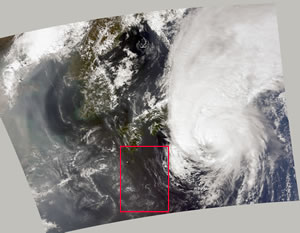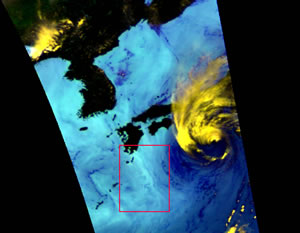 Dec. 3, 2002
Dec. 3, 2002
Observations of a typhoon by a microwave sensor and an optical sensor: Super Typhoon "HIGOS" approaching Japan.
The NASDA-developed ADEOS-II will be launched on December 14, 2002. ADEOS-II is equipped with an optical sensor, the Global Imager (GLI) and the Advanced Microwave Scanning Radiometer (AMSR). GLI will observe the atmosphere, land, oceans and cryosphere with a multichannel advanced sensing capability. AMSR will observe these areas with a microwave system, which enables observations under nearly all weather conditions, night or day and even under cloud cover.
Figure 1:compares RGB composite images derived from MODIS (left) and AMSR-E (right)
| MODIS: Data Provided by NASA | AMSR-E |
 |  |
This figure compares an RGB composite image derived from the Moderate Resolution Imaging Spectroradiometer (MODIS) aboard NASA's Aqua satellite (left) and an RGB composite image from the AMSR-E (right) of Super Typhoon "HIGOS" (Typhoon No. 21) approaching Japan on October 1, 2002. The AMSR-E sensor was developed for Aqua based on the AMSR. The MODIS image is a natural-color image containing clouds, oceans and land as normally seen by human. The AMSR-E image shows parameters related to water such as water vapor in the atmosphere and rain in the clouds that are difficult for
humans to see.
In ADEOS-II, observations by the optical sensor, GLI, and the microwave sensor, AMSR, will be realized. GLI has more 250m high-resolution channels than MODIS and observes steadily with the world's first 1km high-resolution near-ultraviolet channel.
Earth Observation Research and application Center, Japan Aerospace Exploration Agency
JAXA EORC
ALL RIGHTS RESERVED.



